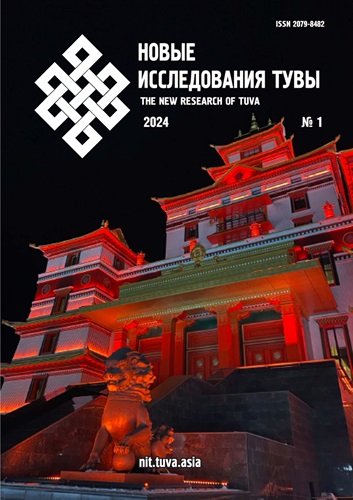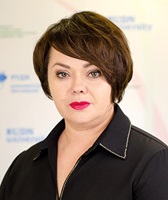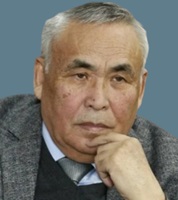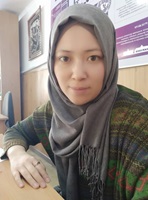The mythologeme of the mountain spirit in the artistic picture of the world by Ch. T. Aitmatov, K.-E. Kudazhy and S. K. Toka
DOI:
https://doi.org/10.25178/nit.2024.1.6Keywords:
mythologeme; mountain spirit; landlord; Tuvan folklore; Kyrgyz folklore; Tuvan literature; Kyrgyz literature; Chingiz Aitmatov; Kyzyl-Enik Kudazhy; Salchak TokaAbstract
The article discusses the specific features of artistic reflection in the work of national writers from Kyrgyzstan and Tuva, who use mythological images that originate in folk tales about human encounters with invisible spirits. The novels by Ch. T. Aitmatov and S. K. Toka, as well as K.-E. Kudazhy, are considered to be vivid examples of this.
It has been established that the inclusion of mythological elements related to mountain spirits in the novels by Tuvan writers is not only a creative strategy used by the authors to draw on ancient motifs. The ethno-cultural context allows for a “modernization” of the genre of legends and stories about mountain spirits, bringing them closer to readers.
Another strategy is presented in Ch. T. Aitmatov's novel “When the Mountains Fall (The Eternal Bride)”, which depicts the transformation of a folklore mythologeme concerning the mountain spirit. Through the hero's familiarization with the world of their ancestors, the author reveals the concept of his spiritual development through the acquisition of love, as well as the path he must follow to achieve this goal.
References
Abramzon, S. M. (1990) Kirghiz and their ethnogenetic and historical-cultural connections. Frunze, Kyrgyzstan. 480 p. (In Russ.).
Azbelev, S. N. (1965) The relationship of tradition, legend and fairy tale to reality (from the point of view of differentiation of genres). In: Slavic folklore and historical reality / ed. By A. M. Astakhova, B. N. Putilov and V. K. Sokolova. Moscow, Nauka. 275 p. Pp. 11–12. (In Russ.).
Akmataliev, A. (1991) Chingiz Aitmatov and the interconnections of literatures. Bishkek, Adabiyat. 182 p. (In Russ.).
Aristov, N. A. (2001) Usuns and Kyrgyz or Kara-Kyrgyz: Essays on the history and life of the population of the western Tien Shan and studies on its historical geography. Bishkek, Ilim. 582 p. (In Russ.).
Bakchiev, T. A. (2019) About the concept of “kaiyp” in the epic “Manas”. Vestnik Severo-Vostochnogo federal'nogo universiteta imeni M. K. Ammosova: seriia Eposovedenie, no. 3 (15), pp. 25–32. (In Russ.).
Bazirchap, A.-H. O. and Kongu, A. A. (2020) Ideas about evil spirits among Tuvans. Vestnik NSU. Series: History and Philology, vol. 19, no. 3: Archaeology and Ethnography, pp. 134–146. (In Russ.). DOI: https://doi.org/10.25205/1818-7919-2020-19-3-134-146
Bakhtin, M. M. (1979) Aesthetics of verbal creativity. Moscow, Art. 424 p. (In Russ.).
Dongak, W. A. (2015) In Search of Three Knowledges. Documentary prose by S. K. Toka. In: Salchak Toka / N. M. Mollerov et al. Moscow, Slovo/Slovo. 544 p. Pp. 372–399. (In Russ.).
Ibraimov, K. (1988) Mythopoetic traditions and works of art: Using the example of the story “Farewell, Gyulsary” by Aitmatov. Sovetskaia tiurkologiia, no. 4, pp. 27–32. (In Russ.).
Ivanov, Vyach. I. (1974) Experience in the interpretation of ancient Indian ritual and mythological terms derived from ASVA — “horse” (horse sacrifice and asvattha tree in ancient India). In: Problems of the history of languages and culture of the peoples of India / ed. By G. A. Zograf and V. N. Toporov. Moscow, Nauka. 268 p. Pp. 75–139. (In Russ.).
Isaeva, A. K. (2016) Features of transformation processes in the epic “Er Toshtyuk” by Sayakbai Karalaev. In: Issues of language, literature and art / ed. By M. A. Rudov. Bishkek, Turar. 161 p. Pp. 96–109. (In Russ.).
The history of Tuva (2001). 2nd ed. / ed. By S. I. Vanshtein and M. Kh. Mannai-ool. Novosibirsk, Nauka. 367 p. (In Russ.).
Klyashtorny, S. G., Basilov, V. N. and Potapov, L. P. (1992) Mythology of Turkic-speaking peoples. In: Myths of the peoples of the world: Encyclopedia: in 2 volumes / ed. By S. A. Tokarev. Moscow, Sovetskaia entsiklopediia. Vol. 2. 751 p. Pp. 536–537. (In Russ.).
Krinichnaya, N. A. (2001) Russian folk mythological prose: Origins and polysemanticism of images. Petrozavodsk; St. Petersburg, Nauka. 582 p. (In Russ.).
Lailieva, I. D. (1988) Traditions of Russian classical and world literature in Kyrgyz prose: M. Elebayev, U. Abdukaimov, Ch. Aitmatov. Frunze, Ilim. 230 p. (In Russ.).
Lotman, Yu. M. (2010) Semiosphere. St. Petersburg, Art-SPB. 704 p. (In Russ.).
Mizhit, L. S. (2009) Triple images in the mythology and folklore of the Tuvans. New Research of Tuva, no. 4, pp. 173–188. (In Russ.).
Neklyudov, S. Yu. (1981) Mythology of the Turkic and Mongolian peoples (Problems of interrelations). Tiurkologicheskii sbornik 1977 / ed. By A. N. Kononov et al. Moscow, Nauka. 296 p. Pp. 183–203. (In Russ.).
Neklyudov, S. Yu. (1984) On some aspects of the study of folklore motifs. In: Folklore and ethnography: At the ethnographic origins of folklore plots and images: collection of scientific works / ed. By B. N. Putilov. Leningrad, Nauka. 256 p. Pp. 221–229. (In Russ.).
Panchenko, A. A. (1998) Research in the field of folk Orthodoxy. Village shrines of North-West Russia. St. Petersburg, Aletheia. 305 p. (In Russ.).
Pomortseva, N. V. and Krasilnikova, S. V. (2023) The specifics of constructing ethnic identity in intercultural discourse (On the question of the linguocultural adaptation of the medieval author of “Walking across Three Seas Afanasy Nikitin”). Philological Sciences. Scientific reports of higher education, issue 6s (Special Issue), pp. 21–30. (In Russ.). DOI: https://doi.org/10.20339/PhS.6s-23.021
Putilov, B. N. (1994) Folklore and folk culture. St. Petersburg, Nauka. 235 p. (In Russ.).
Samdan, Z. B. (1987) From folklore to literature (based on Tuvan prose of the 40–70s). Kyzyl, Tuvan book publishing house. 78 p. (In Russ.).
Sadykov, K. D. (1989) Folklore elements in the plot-compositional structure of Ch. Aitmatov’s novel “And the day lasts longer than a century”. In: Kyrgyz literature in the context of Russian artistic culture: collection of scientific works / ed. By Ch. T. Dzholdosheva. Frunze, Mir. 176 p. Pp. 29–37. (In Russ.).
Stebleva, I. V. (2007) Life and literature of pre-Islamic Turks, historical and cultural context of ancient Turkic literature. Moscow, Eastern literature. 208 p. (In Russ.).
Stepanov, Yu. S. (1997) Constants: Dictionary of Russian culture. Moscow, Languages of Russian culture. 824 p. (In Russ.).
Terebikhin, N. M. (1993) Sacred geography of the Russian North. Arkhangelsk, Publishing House of the Pomeranian International Pedagogical University. 220 p. (In Russ.).
Tyupa, V. I. (2001) Narratology as an analyst of narrative discourse (“The Bishop” by A. P. Chekhov). Tver, Tver State University. 58 p. (In Russ.).
White, H. (2002) Metahistory: The Historical Imagination in Nineteenth-Century Europe / trans. from English ed. by E. G. Trubinon and V. V. Kharitonova. Ekaterinburg, Ural University Publ. 528 p. (In Russ.).
Ushnitsky, V. V. (2020) Some Aspects of the Study of the Ethnogenesis of the Tuvan People. Vestnik NSU. Series: History and Philology, vol. 19, no. 5: Archaeology and Ethnography, p. 146–155. (In Russ.) DOI: https://doi.org/10.25205/1818-7919-2020-19-5-146-155
Hadakhane, M. A. (2009) Good and Evil in the novel by K. E. Kudazhy. Kyzyl, Tuvan Book Publishing House named after Yu. Sh. Kunzegesh. 296 p. (In Russ.)
Cherepanova, O. A. (1983) Mythological vocabulary of the Russian North. Moscow, Publishing House of LSU. 169 p. (In Russ.)
Schmid, B. (2003) Narratology. Moscow, Iazyki slavianskoi kul'tury. 312 p. (In Russ.)
Published
How to Cite
For citation:
Pomortseva N. V., Krasilnikova S. V., Tagaev M. Dzh., Chinloda M. S., Ernisova A. E. The mythologeme of the mountain spirit in the artistic picture of the world by Ch. T. Aitmatov, K.-E. Kudazhy and S. K. Toka. New Research of Tuva, 2024, no. 1, pp. 88-103. (In Russ.). DOI: https://doi.org/10.25178/nit.2024.1.6
Issue
Section

This work is licensed under a Creative Commons Attribution-NonCommercial 4.0 International License.

Author(s) license holder(s) grant rights for their work to the journal (grantee of a license) under the simple non-exclusive open license in accordance with Art. 1286.1 «Open license for a research work, work of literature or fine arts», Civil Code of the Russian Federation.
New Research of Tuva publishes articles under the Creative Commons Attribution-NonCommercial license (CC BY-NC).
Since it is an open license, author(s) reserve the right to upload the article to their institutional repository, submit it to another journal (if it allows republications), or republish it on their own website (in full, or in part).
However, several conditions apply here:
a) The republished version must always contain the name(s) and affiliation(s) of the author(s), the original title and the hyperlink to the original version on the New Research of Tuva website;
b) It must be in open access, free of charge, and no category of readers must be in any way whatsoever advantaged over general readership.
c) should the contribution be submitted elsewhere by its author(s) without substantial modification (30% or more of original text unchanged), the body of the article should contain a disclaimer that the original version was published in New Research of Tuva (with a link to the respective page)
The CC-BY-NC is a non-revocable license which applies worldwide and lasts for the duration of the work’s copyright.













